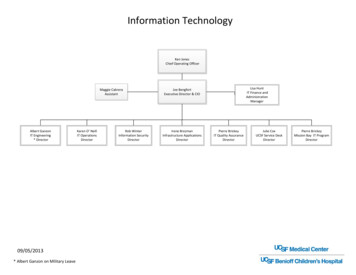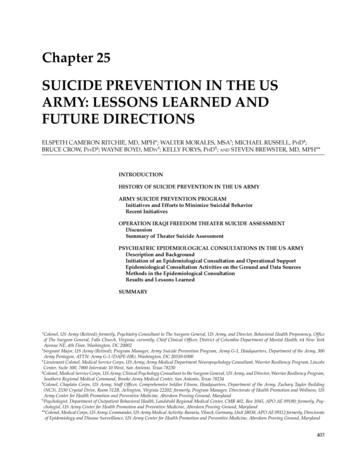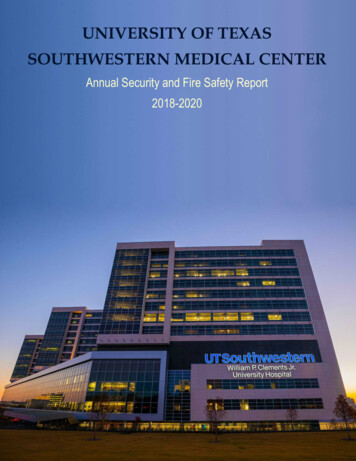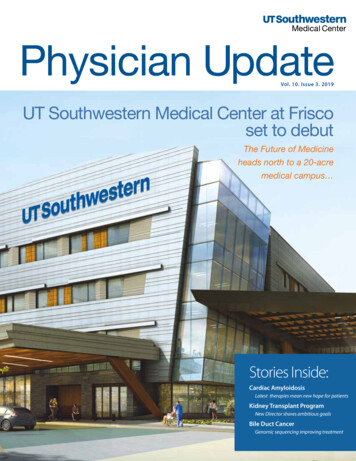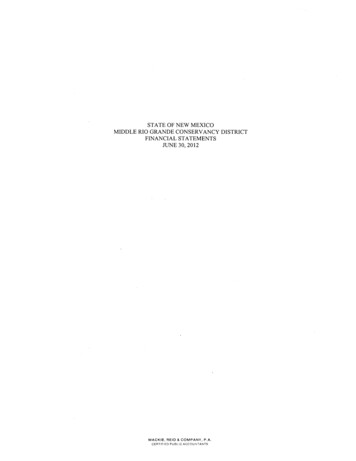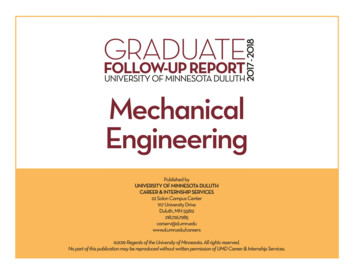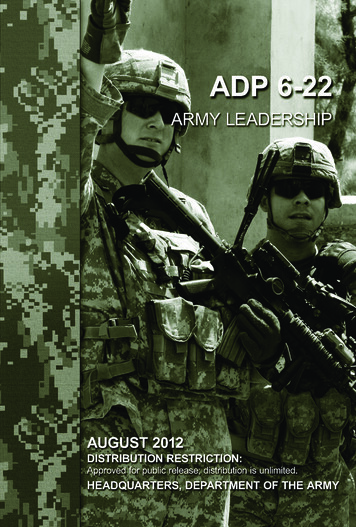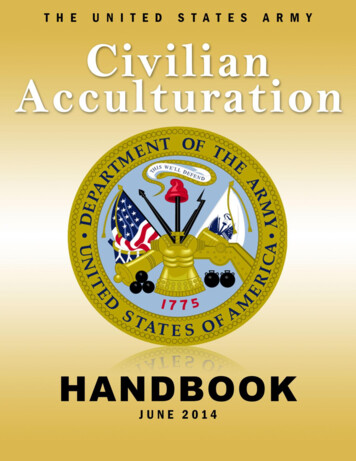
Transcription
DEPARTMENT OF THE ARMYUS ARMY ENGINEER DIVISION, SOUTHWESTERN1100 COMMERCE STREET, SUITE 831DALLAS TX 75242-1317REPLY TOATIENTIONOF0 7 DEC 2012CESWD-RBT-WMEMORANDUM FOR Commander, Fort Worth DistrictSUBJECT: Proctor Dam, Texas, Phase II Issue Evaluation Study (P2 # 139884) Review PlanApproval1. References:a. EC 1165-2-209, Civil Works Review Policy, 31 Jan 2010; and Change 1, 3 1 January 2012.b. Memorandum, CEIWR-RMC, 28 November 12, subject: Risk Management CenterEndorsement - Proctor Dam, TX - IES Review Plan (Enc1 1).c. Final Review Plan (RP) for Proctor Dam Phase 1f Issue Evaluation Study (Encl 2).2. In accordance with reference I .a. , I hereby approve the enclosed RP for the subject projectstudy.3. Please post the final approved RP with a copy of this memorandum to the District's publicinternet website. Prior to posting to the District website, the names ofUSACE employees shouldbe removed.4. The SWD point of contact for this action is Mr. Michael Sou them, CESWD-RBT-W, at 918-669-7148. .K.L2 Encl sasCF:CESWF-EC-DG/ Vazquez (w/encls)THOMAS W. KULABrigadier General, USACommanding
DEPARTMENT OF THE ARMYRISK MANAGEMENT CENTER, CORPS OF ENGINEERS13952 DENVER WEST PARKWAY SUITE 200GOLDEN, CO 80401REPLY TOATIENTION OFCEIWR-RMC-WDCEIWR-RMC28 November 2012MEMORANDUM FOR: Commander, Fort Worth District, A1TN: CESWF-EC-DGSUBJECT: Risk Management Center Endorsement - Proctor Dam, TX- IES Review PlanI. The Risk Management Center (RMC) has reviewed the Review Plan (RP) for the Proctor Dam, dated20 November 2012, and concurs that this RP provides for an adequate level of peer review and complieswith the current peer review policy requirements outlined in EC 1165-2-209 "C ivil Works ReviewPolicy", dated 31 January, 2010.2. This review plan was prepared by the Fort Worth District, reviewed by the Southwestern Division andthe RMC, and all review comments have been satisfactori ly resolved.3. The RMC endorses this document to be approved by the MSC Commander. Upon approval of the RP,please provide a copy of the approved RP, a copy of the MSC Commander's approval memorandum, anda link to where the RP is posted on the District website to Tom Bishop, RMC Senior Review Manager(lhomas.w.bishop@usace.army. mil).4. Thank you for the opportunity to assist in the preparation of this RP. Please coordinate all aspects ofthe Agency Technical Review. For further information, please do not hesitate to contact me at (3 03) 9634556.Sincerely, THOMAS W. BISHOP, P.E.Senior Review ManagerRisk Management CenterCF:CEIWR-RMC-ZA (Mr. Snorteland)CESWD (Division Quality Manager)
Proctor DamPhase II IES Review PlanFor Implementation Documents and Other Work Products Southwestern Division (SWD)Fort Worth District (SWF)U.S. Army Corps of Engineers20 November 2012Project P2 Number 139884Project Manager:Michael KingstonLead Engineer:1DPH 5HPRYHGReview Plan SWF POC: Jason VazquezReview Plan SWD POC: Michael SouthernMSC Approval Date:7 December 2012Last Revision Date:
REVIEW PLANProctor Dam, TexasPhase II Issue Evaluation StudyTABLE OF CONTENTS1.INTRODUCTION . 2A.B.C.D.E.F.2.PURPOSE . 2STUDY/PROJECT DESCRIPTION . 2FACTORS AFFECTING THE SCOPE AND LEVEL OF REVIEW . 3LEVELS OF REVIEW . 4REVIEW TEAM . 5MINIMUM QUALIFICATIONS . 6REQUIREMENTS . 6A.B.REVIEWS. 6APPROVALS . 83.GUIDANCE AND POLICY REFERENCES . 94.SUMMARY OF REVIEWS AND APPROVALS. 95.MODEL CERTIFICATION AND APPROVAL . 9A.B.REGULATION . 9MODELS . 106.REVIEW SCHEDULES AND COSTS. 117.PUBLIC PARTICIPATION . 118.EXECUTION . 11A.B.C.D.E.9.GENERAL . 11DR. CHECKS: . 12ATR REVIEW AND CONTROL . 12DOCUMENTATION OF ATR . 13CERTIFICATION OF ATR . 13REVIEW PLAN POINTS OF CONTACT . 14ATTACHMENT 1: TEAM ROSTERS . 15ATTACHMENT 2: SAMPLE STATEMENT OF TECHNICAL REVIEW FOR DECSION DOCUMENTS. 17ATTACHMENT 3: REVIEW PLAN REVISIONS . 18ATTACHMENT 4: ACRONYMS AND ABBREVIATIONS . 19Proctor Dam Phase II IES Review Plan1
1. INTRODUCTIONa. PurposeThis Review Plan is intended to ensure a quality-engineering Dam Safety Issue Evaluation Study developedby the Corps of Engineers. ER 1110-2-1156, “Dam Safety Policy and Procedures” dated 28 Oct 2011, Chapter8 describes the Issue Evaluation Study (IES) Plan development, review, and approval process. This ReviewPlan has been developed for Proctor Dam. This Review Plan was prepared in accordance with EC 1165-2209, “Civil Works Review Policy”, and covers the review process for the Proctor Dam Phase II IES Report.The IES is a study that may lead to additional studies, modeling, or NEPA consultation. NEPA compliancewould occur during the Dam Safety Modification Study Phase. The intent of this document is to performfurther investigation, evaluate risk, gauge the effectiveness of interim risk reduction measures, and justifythe need to pursue or not pursue Dam Safety Modification Studies. It is imperative that the vertical teamingefforts are proactive and well coordinated to assure collaboration of the report findings, conclusions, andrecommendations, and that there is consensus at all levels of the organization with the recommended pathforward.b. Study/Project DescriptionProctor Dam was screened by a national risk cadre on May 15, 2006 as part of the FY06 Screening forPortfolio Risk Analysis (SPRA). Based on the results of this risk screening, the dam was categorized as DamSafety Action Class (DSAC) III (High Risk). However, the original engineering ratings were revised based onthe flood events of 2007, which resulted in Proctor Dams DSAC rating changing from III to II (Very High Risk).Congressional authority for the construction of Proctor Lake, is contained in the Flood Control Act, approved3 September 1954 (Public Law 780, 83d Congress, 2d Session) in accordance with the plan of improvementas outlined in House Document No. 535 (81st Congress, 2d Session). Authority to initiate advance planningon the Proctor Lake project is contained in the Public Works Appropriation Act of 1957, approved 2 July1956 (Public Law 641, 84th Congress, 2nd Session) and in Advice of Allotment C-56, dated 20 July 1956.The primary purposes of Proctor Dam are flood control, water supply, and recreation.Proctor Dam is located at river mile 238.9 on the Leon River, about 8 miles northeast of Comanche, Texas.The project includes a 13,020 feet long, zoned earth main embankment, with a maximum height of 86 feet,crest width of 30 feet, and a top elevation of 1206.0 feet. The concrete ogee spillway is equipped with 11,40-foot by 35-foot tainter gates, and spillway discharge channel width of 520 feet. The low flow facilitiesconsist of four, 48-inch diameter conduits located in the spillway gate piers and controlled by 48-inchdiameter slide gates at the upstream intakes. All elevations mentioned in this document are expressed infeet, NGVD. A General Plan View is provided as Plate 1 and a typical embankment/foundation sections areprovided on Plate 2.Construction of Proctor Dam started in January 1961 and the project was placed in operation in 1964.Deliberate impoundment began in September 1963, and conservation pool, elevation 1162, was firstattained in September 1964. The pool of record was established on May 2, 1990 when the reservoir reachedelevation 1197.62. The second pool of record was established on July 5, 2007, when significant amounts ofseepage emerged along the toe of the terrace section of the embankment to the left of the spillway.Proctor Dam Phase II IES Review Plan2
Proctor Dam has a long history of seepage. In 1963, seepage was noted as soon as the pool reachedelevation 1155, 7 feet below the top of conservation pool. Ponding appeared downstream of theembankment, which indicated that the seepage is flowing underneath the dam rather than through it. Priorto the project, the area immediately below the dam was farmland. However, since impoundment of thelake, wetlands have developed downstream of the embankment toe in the area that was the river bottom.The project record reservoir pool elevation 1197 was reached in 1990 and then in the 2007 flood event areservoir pool elevation 1192 occurred. During both of these flood events extensive seepage along thedownstream embankment toe from about station 45 00 to station 65 00 was observed. The seepageobserved consisted of numerous pin boil seepage points along the downstream toe with surface seepagewater. From observations it is noted that the degree of seepage was greater during the 2007 flood event,although the reservoir pool elevation was lower than the 1990 record pool by 5 feet. It was observed in the2007 flood event that when the reservoir pool elevation dropped lower than elevation 1185 the movementof soil particles (fine sands) in the pin boil seepage points stopped and once the reservoir pool elevationdropped lower than elevation 1174 then the observed seepage along the downstream embankment toestopped.In addition to the observed seepage during the 1990 and 2007 flood events there is continuous seepageoccurring at about station 64 00 even at reservoir pool levels below conservation pool level 1162. This isthe area where fine sands were encountered at shallow depths in a dug trench. This area is very swampywith soft unstable ground starting at about 50 feet D/S of the embankment toe. Because of the observedseepage and soil particle movement above reservoir pool elevation 1185, internal erosion of the foundationat the terrace and transition sections was considered a plausible failure mode.From review of the subsurface boring logs taken during design and post completion of construction it isapparent that the geological subsurface conditions for the terrace alluvium deposit for the embankmentfoundation indicates that there is not a continuous pervious material at or near natural ground surface.These alluvium terrace soils are discontinuous lenticular soil deposits. As part of the Phase II IESInvestigation, to better define subsurface conditions CPTs were taken and the geological section at Station43 50 and 59 00 were developed from the CPTs and are shown in Plate 2.Potential failure modes were derived from the SPRA performed on May 15, 2006 (updated October 3, 2007).The SPRA considered the following three pool elevations as initiating events for Proctor Dam: Normal (10-yrreturn period) at 1177.5, Unusual (300-yr return period) at 1201.5 and Extreme (10,000-yr return period) at1208.3. The following primary concerns were identified by the SPRA and summarized in the SPRA report:(1) Foundation Seepage and Piping considered Probably Inadequate under Unusual-Extreme loadingconditions based on known seepage conditions, including boils and voids.(2) Embankment Erosion considered Inadequate under Unusual-Extreme loading conditions based onovertopping and embankment materials susceptible to erosion.(3) Spillway Abutment Seepage and Piping considered Probably Inadequate under Unusual-Extremeloading conditions due to overtopping and erosion behind the training walls.c. Factors Affecting the Scope and Level of ReviewAn Issue Evaluation Study was initiated to evaluate the primary concerns indentified in the SPRA, quantifythe deficiencies, and to devise a clear path forward for initiation of a Dam Safety Modification Study (DSMS)if the IES investigation warrants such action.Proctor Dam Phase II IES Review Plan3
The initial IES was presented to QCC on 8 April 2010. After completion of the initial IES investigation it wasrecommended by the Senior Oversight Group that the Proctor Dam be classified as a DSAC III and furtherinvestigation under a Phase II IES be conducted with regard to:(a) Thoroughly describing the failure mode with respect to internal erosion in the foundation terracedeposits at the terrace and transition embankment sections PFM # 2A & 3A(b) Investigations and analysis as to the appropriateness of the design and construction of a WeightedFilter Berm that will address the risks associated with PFM # 2A & 3A.(c) Further investigate the internal erosion at the interface of the embankment fill and the concreteface of the spillway non-overflow sections PFM # 1.(d) Re-visit and re-analyze the hydrologic failure modes PFM # 8.Following those actions, the risk assessment should be re-visited and included in the revised IES report.To reduce risk CESWF developed an IRRM in this D/S area from about station 41 25 to station 65 50. TheIRRM consists of an inverted filter berm 4 to 6 feet thick from about station 41 25 to 65 50 ranging from 70feet wide at station 41 25 up to about 200 feet wide at station 65 50. The inverted filter berm will beconstructed to contain uplift from the exiting under seepage and extend the unfiltered exit seepage path.The extension of the seepage path will perform two functions. The first is a decreased exit gradient whichwill reduce the chance of piping. The second is if the exit gradient is still high enough and piping shouldoccur, it will increase the time for intervention to stop the piping and increase the warning timedownstream. The inverted filter berm consists of a two foot thick filter sand overlain by an additional twofeet of random fill for additional weight. This IRRM was awarded in September 2012 and construction willcommence April 2013.d. Levels of ReviewThis review plan was developed in accordance with EC 1165-2-209, which establishes an accountable,comprehensive, life-cycle review strategy for Civil Works products by providing a seamless process forreview of all Civil Works projects from initial planning through design, construction, and operation,maintenance, repair, replacement and rehabilitation (OMRR&R). The EC outlines four general levels ofreview:(1)(2)(3)(4)District Quality Control/Quality Assurance (DQC)Agency Technical Review (ATR)Independent External Peer Review (IEPR)Policy and Legal Compliance Review.As per ER 110-2-1156, a Quality Control and Consistency (QCC) review will be conducted in conjunction withthe ATR including the district, MSC, and RMC. The RMC will certify that the risk assessment was completedin accordance with the USACE current guidelines and best risk management practices.Independent External Peer Review (IEPR) is applied in cases that meet certain criteria. This IES is not adecision document and does not cover work requiring a Type I or Type II IEPR. Issue Evaluation Studies areused to justify Dam Safety Modification Studies. If this project requires a Dam Safety Modification Study,both Type I and Type II IEPR will be conducted.Proctor Dam Phase II IES Review Plan4
e. Review TeamThe USACE Risk Management Center (RMC) is the Review Management Organization (RMO) for dam safetyrelated work, including this IES. Contents of this review plan have been coordinated with the RMC and theSouthwestern Division, the Major Subordinate Command (MSC). Informal coordination with SWD will occurthroughout the IES development, including briefings to the SWD Dam Safety Committee and ProgramReview Board updates. In-Progress Review (IPR) team meetings with the RMC, SWD, and HQ will bescheduled on an “as needed” basis to discuss programmatic, policy, and technical matters. The SWD DamSafety Program Manager will be the POC for vertical team coordination. This review plan will be updated foreach new project phase.Agency Technical Review Team:ATR Lead: The ATR team is a senior professional with extensive experience in preparing Civil Worksdocuments and conducting ATRs (or ITRs). The lead has the necessary skills and experience to lead a virtualteam through the ATR process. The ATR lead may also serve as a reviewer for a specific discipline, in thiscase, (List: Structural Engineering, Geotechnical Engineering, etc.)Required ATR Team Expertise: The ATR team will be chosen based on each individual’s qualifications andexperience with similar projects. Based on the project and known site conditions, the following disciplineswill be needed for the Project Delivery Team (PDT) and subsequent review efforts.(1) Geotechnical Engineer - Shall have experience in the field of geotechnical engineering, analysis,design, and construction of earthfill embankment dams. The geotechnical engineer shall haveexperience in subsurface investigations, rock and soil mechanics, internal erosion (seepage andpiping), slope stability evaluations, erosion protection design, and earthwork construction. Thegeotechnical engineer shall have knowledge and experience in the forensic investigation of seepage,settlement, stability, and deformation problems associated with high head dams and appurtenancesconstructed on rock and soil foundations.(2) Engineering Geologist - Shall have experience in assessing internal erosion (seepage and piping) andstability of earthfill embankment dams constructed on Shale and Clay Shale formations. Theengineering geologist shall be familiar with identification of geological hazards, explorationtechniques, field and laboratory testing, and instrumentation. The engineering geologist shall beexperienced in the design of grout curtains and must be knowledgeable in grout theology, concretemix designs, and other materials used in foundation seepage barriers.(3) Hydrologist – Shall have experience in water management especially with managing water outflowsfrom a reservoir. Will also have experience with characterizing surface water flows in a watershedusing inundation mapping software, HEC‐HMS, HEC‐ResSim, and other water‐flow scenariodevelopment techniques.(4) Hydraulic Engineer – Shall have experience in the analysis and design of hydraulic structures relatedto dams including the design of hydraulic structures (e.g., spillways, outlet works, and stilling basins)with Flo‐2D models and HEC-RAS. The hydraulic engineer shall be knowledgeable and experiencedwith the routing of inflow hydrographs through multipurpose flood control reservoirs utilizingmultiple discharge devices, Corps application of risk and uncertainty analyses in flood damagereduction studies, and standard Corps hydrologic and hydraulic computer models used in drawdownstudies, dam break inundation studies, hydrologic modeling and analysis for dam safety.Proctor Dam Phase II IES Review Plan5
(5) Structural Engineer – Shall have experience and be proficient in performing stability analysis, finiteelement analysis, seismic time history studies, and external stability analysis including foundationson high head mass concrete dams. The structural engineer shall have specialized experience in thedesign, construction and analysis of concrete dams and project components.(6) Civil Engineer – Shall have experience and expertise in utility relocations, positive closurerequirements, civil design, and non‐structural flood damage reduction.(7) Environmentalist (or Planning Specialist) – Shall have experience and understand the requirementsfor decision documents and NEPA documentation.(8) Economist (or Consequence Specialist) – Shall be knowledgeable of policies and guidelines of ER1110-2-1156 as well as experienced in analyzing flood risk management projects in accordance withER 1105-2-100, the Planning Guidance Notebook. The economist shall be knowledgeable andexperienced with standard Corps computer models and techniques used to estimate population atrisk, life loss, and economic damages.(9) Mechanical/Electrical Engineer – Shall have experience in machine design, machine rehabilitationand familiarity with design of mechanical gates and controls for flood control structures.(10)Maintenance Engineer – Shall have experience with project operations and maintenance conditionsand procedures.f.Minimum QualificationsTo ensure the technical adequacy and adherence to criteria for the IES assessment, all technical resourcesshall have the following minimum qualifications. Licensed Professionals shall be used for all review effortswhen applicable with relevant experience with Dam Safety/Risk Management principles and practice.Review Disciplines /Required Experience (Yrs)DQCATRGeotechnical EngineeringEngineering GeologistStructural Engineering10510151015Hydrology5*Hydraulic Engineering1015Civil es/Economics1015* Hydrology review shall be conducted by Hydraulic Engineer.** Civil review shall be conducted by Geotechnical/Structural Engineers.*** Planning/Environmental review shall be conducted by Consequences/Economics Specialist.2. REQUIREMENTSa. ReviewsThe review of all work products will be in accordance with the requirements of EC 1165-2-209 by followingthe guidelines established within this review plan. All engineering and design products will undergo DistrictQuality Control Reviews.Proctor Dam Phase II IES Review Plan6
(1) District Quality Control (DQC)DQC is the review of basic science and engineering work products focused on fulfilling the projectquality requirements. DQC will be performed for all district engineering products by staff notinvolved in the work and/or study. Basic quality control tools include a plan providing for seamlessreview, quality checks and reviews, supervisory reviews, Project Delivery Team (PDT) reviews, etc.(2) Agency Technical Review (ATR)ATR is an in-depth review, managed within USACE, and conducted by a qualified team outside of thehome district that is not involved in the day-to-day production of the project/product. The purposeof this review is to ensure the proper application of clearly established criteria, regulations, laws,codes, principles and professional practices. The ATR team reviews the various work products andassure that all the parts fit together as a coherent whole.ATR teams will be comprised of senior USACE personnel (Regional Technical Specialists, etc.), andmay be supplemented by outside experts as appropriate. To assure independence, the leader of theATR team shall be from outside the home Major Subordinate Command (MSC).(3) Quality Control and Consistency (QCC) ReviewIn conjunction with the ATR review, the RMC shall facilitate a QCC discussion for the district and therisk assessment cadre to present the baseline risk assessment, risk management alternativesconsidered, and the recommended risk management plan for review by a panel of Dam Safetyprofessionals.(4) Policy Compliance ReviewThe MSC and HQ will conduct agency policy compliance review. The Risk Management Center willreview the risk estimate and verify that risk estimate is in compliance with the current policy fordam safety risk estimates. The Risk Management Center will review the risk managementrecommendations and verify the estimated risk reductions.(5) Senior Oversight Group (SOG) ReviewUpon completion of any QCC amendments, the district presents the baseline risk assessment, riskmanagement alternatives considered, and the recommended risk management plan to the damsafety senior oversight group (SOG).(6) Independent External Peer Review (IEPR)IEPR is the most independent level of review, and is applied in cases that meet certain criteria. ThisIES is not a decision document and does not cover work requiring a Type I or Type II IEPR. IssueEvaluation Studies are used to justify Dam Safety Modification Studies. If this project requires a DamSafety Modification Study, both Type I and Type II IEPR will be conducted.(7) Policy and Legal Compliance ReviewPolicy and Legal Compliance Review is required for decision documents. Since this IES is not adecision document it does not require a Policy and Legal Compliance Review. If this project requiresa Dam Safety Modification Study, a Policy and Legal Compliance Review will be conducted.(8) Peer Review of Sponsor In-Kind ContributionsThere will be no in-kind contributions for this IES.Proctor Dam Phase II IES Review Plan7
The district and the risk assessment cadre present the risk assessment, findings, conclusions, andrecommendations for review to the QCC panel. After resolution of ATR and QCC review comments, the MSCand HQUSACE will complete quality assurance and policy compliance review. Then the district will presentthe report findings and recommendations to the Senior Oversight Group (SOG). Once any SOG commentsare resolved the district DSO, MSC DSO, and the SOG Chair will sign a joint memorandum approving thefindings and recommendations of the report.b. Approvals(1) Review Plan Approval and UpdatesThe MSC for this IES is the Southwestern Division. The MSC Commander is responsible for approvingthis Review Plan. The Commander’s approval reflects vertical team input (involving the Fort WorthDistrict, MSC, RMC and HQUSACE members) as to the appropriate scope and level of review for thestudy and endorsement by the RMC. Like the Study Plan, the Review Plan is a living document andmay change as the study progresses. The District is responsible for keeping the Review Plan up todate. Minor changes to the review plan since the last MSC. Commander approval will bedocumented in an Attachment to this plan.Significant changes to the Review Plan (such as changes to the scope and/or level of review) shouldbe re-endorsed by the RMC and re-approved by the MSC Commander following the process used forinitially approving the plan.The latest version of the Review Plan, along with the Commanders’ approval memorandum, will beposted on the District’s webpage and linked to the HQUSACE webpage.(2) IES ReportThe IES Report shall undergo a DQC and formal ATR. After the ATR, the PDT will present the IES tothe Quality Control and Consistency (QCC) Panel for review. The district and the risk assessmentcadre present the IES risk assessment, IES findings, conclusions, and recommendations for review.After the QCC meeting, the Risk Cadre and RMC will certify that the risk estimate was completed inaccordance with the Corps’ current guidelines and risk management best practices. The IES will thenbe presented to the Senior Oversight Group (SOG). The SOG generally consists of the followingmembers: Special Assistant for Dam Safety (Chair)Geotechnical CoP LeaderMaterials CoP LeaderStructural CoP LeaderHydraulics and Hydrologic CoP LeaderRegional representatives determined by Special Assistant for Dam Safety; Corps Business Line &Program Representatives to include D
submittal, review, and approval process. The Risk Management Center (RMC) is responsible for coordinating and managing agency technical review of the IES Report in accordance with EC 1165-2-209. The ATR Lead will be an RMC team member unless otherwise approved by the RMC Director. The ATR Lead in cooperation with the PDT,


